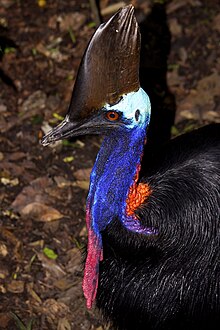Palaeognathae
| Paleognaths | |
|---|---|

| |
| Southern cassowary (Casuarius casuarius) | |
| Scientific classification | |
| Domain: | Eukaryota |
| Kingdom: | Animalia |
| Phylum: | Chordata |
| Class: | Aves |
| Infraclass: | Palaeognathae Pycraft, 1900 |
| Orders | |
The Palaeognathae, or paleognaths (from Ancient Greek palaió- "old" + gnáthos "jaw") is one of two living clades of birds: the other is the Neognathae. Together, the two clades make up the clade Neornithes.
Palaeognathae includes five living branches of flightless birds (plus two extinct clades), called ratites, and one flying lineage, the Neotropic tinamous.[1][2] There are 47 species of tinamous, five of kiwis (Apteryx), three of cassowaries (Casuarius), one of emus (Dromaius) (another emu became extinct in historic times), two of rheas (Rhea) and two of ostriches (Struthio).[3]
Recent research has shown that palaeognaths are monophyletic but the traditional taxonomic split between flightless and flighted forms is incorrect. Tinamous are within the ratite radiation. Flightlessness arose independently a number of times by parallel evolution.[4]
There are three extinct groups that are undisputed members of Palaeognathae: the Lithornithiformes, the Dinornithiformes (moas) and the Aepyornithiformes (elephant birds).
References[change | change source]
- ↑ Wetmore A. 1960. A classification for birds of the world. Smithsonian Miscellaneous Collection (Washington D.C.: Smithsonian Institution) 139: 1–37.
- ↑ Baker A.J; Haddrath O; McPherson J.D; Cloutier A. 2014. Genomic support for a moa-tinamou clade and adaptive morphological convergence in flightless ratites. Molecular Biology and Evolution. 31 (7): 1686–1696.
- ↑ Clements, J.F. Schulenberg, T.S. Iliff, M.J. Sullivan, B.L. & Wood, C.L. (2010) The Clements checklist of the birds of the world: Version 6.5.
- ↑ Mitchell K.J; Llamas B.; Soubrier J; Rawlence N.J; Worthy T.H; Wood J; Lee M.S.Y; Cooper A. 2014. Ancient DNA reveals elephant birds and kiwi are sister taxa and clarifies ratite bird evolution (PDF). Science. 344 (6186): 898–900.
